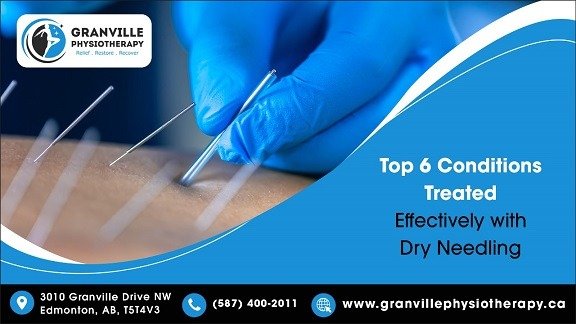Dry needling is a technique used by therapists to alleviate muscle pain, improve range of motion, and promote healing. It includes the insertion of thin, solid needles directly into trigger points or tight bands of muscle tissue. These trigger points are areas of hyperirritability within the muscle, often associated with muscle knots or areas of tension. Dry needling therapy in Edmonton aims to elicit a localized twitch response, which is a reflexive contraction of the muscle fibres. This twitch response helps to release muscle tension, enhance blood flow, and stimulate the body’s natural healing processes.
Top 6 Conditions Treated Effectively with Dry Needling:
Dry needling in Edmonton treats various musculoskeletal conditions. While the effectiveness of dry needling can vary from person to person, some common conditions that are often treated effectively with dry needling include:
Myofascial Pain Syndrome:
Myofascial Pain Syndrome (MPS) involves trigger points in muscle tissue, leading to pain, stiffness, and limited movement. Dry needling entails the insertion of fine needles into affected muscles, targeting these trigger points to release tension and promote healing. By stimulating a localized twitch response, dry needling alleviates discomfort and improves blood flow. This approach effectively addresses muscular dysfunctions, providing relief and enhancing mobility for MPS sufferers.
Chronic Pain:
Dry needling addresses chronic pain conditions like fibromyalgia, chronic low back pain, and neck pain. Targeting specific trigger points in affected muscles can alleviate muscle tightness and tension, common culprits behind persistent discomfort. This technique can particularly benefit those with fibromyalgia, offering relief from widespread muscle tenderness. Moreover, for individuals with chronic back or neck pain, dry needling can enhance mobility by releasing tension around the spine.
Shoulder Impingement Syndrome:
Dry needling may offer advantages as a treatment approach for shoulder impingement syndrome, a condition marked by discomfort and restricted movement in the shoulder due to compression of the tendons and bursa in the shoulder joint. This compression often occurs when the space between the acromion and the rotator cuff tendons narrows, leading to irritation and inflammation. Dry needling aims to address muscle tightness and trigger points located in the muscles surrounding the shoulder joint, like the rotator cuff muscles, deltoid, and muscles of the shoulder girdle. By inserting thin needles into these trigger points, dry needling can help release muscle tension, minimize pain, and improve shoulder mobility.
Tennis Elbow (Lateral Epicondylitis):
Dry needling has shown effectiveness in treating tennis elbow, medically known as lateral epicondylitis. This condition entails inflammation or degeneration of tendons on the outer side of the elbow, often resulting from repetitive gripping or wrist extension motions, such as those used in tennis or other sports. Dry needling targets trigger points and tight bands of muscle in the forearm and surrounding areas, aiming to reduce muscle tension and alleviate pain associated with tennis elbow. By inserting thin needles into these trigger points, dry needling can stimulate a healing response, enhance blood circulation to the impacted region and stimulate the body’s natural pain-relieving endorphins compounds.
Sciatica:
Sciatica, characterized by radiating pain extending down the leg along the sciatic nerve, originating from the lower back, often results from nerve compression in the lumbar spine, impairing mobility and quality of life. Dry needling targets specific muscles that contribute to nerve compression, alleviate tension and reduce pressure on the sciatic nerve. By precisely inserting fine needles into these muscles, dry needling prompts localized responses, relaxing muscles and improving blood flow to alleviate pain and discomfort.
Plantar Fasciitis:
Plantar fasciitis causes sharp heel pain, especially noticeable during the first steps after waking up or after rest. It occurs due to inflammation affecting the plantar fascia, the tissue supporting the foot’s arch. Dry needling targets specific calf and foot muscles to relieve tension contributing to plantar fasciitis. Thin needles inserted into trigger points induce muscle relaxation and enhance blood flow. This technique, combined with stretching exercises and orthotics, can reduce pressure on the plantar fascia, alleviate pain, and promote healing. However, results may vary, necessitating guidance from a professional therapist. Addressing factors like footwear and gait mechanics is essential for long-term management.
Empowering Movement:
Dry needling in Edmonton emerges as a therapeutic approach for addressing a spectrum of musculoskeletal ailments, offering targeted relief where traditional treatments may fall short. By pinpointing and deactivating trigger points within muscles, this technique holds the potential to alleviate pain, enhance mobility, and promote healing. However, its efficacy is contingent upon skilled application by trained practitioners and adherence to individualized treatment plans. As a component of a holistic strategy for musculoskeletal well-being, Granville Physiotherapy in Edmonton offers hope and renewed vitality to those grappling with persistent pain functional limitations and expands its utility in the realm of physical rehabilitation and wellness.
For those seeking a holistic approach to IMS therapy in Edmonton, Granville Physiotherapy provides specialized dry needling tailored to your specific requirements. Our dedicated team offers compassionate care and innovative treatment techniques aimed at improving mobility, managing pain, and enhancing overall wellness. Let Granville Physiotherapy support you in overcoming physical obstacles through dry-needling interventions. Reach out to us today via www.granvillephysiotherapy.ca or by calling +1 (587) 400-2011 to book your consultation and embark on your path to better health and increased mobility with personalized dry needling therapy in Edmonton.
Read More: Tips for Choosing the Right Primary Care Physician
